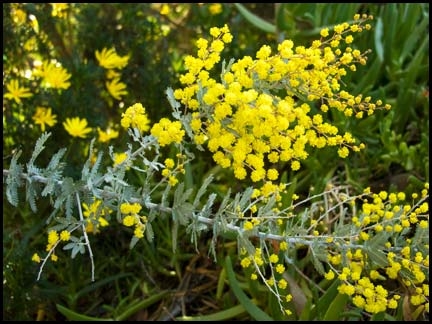Recently I had the honor to tour a remarkable garden in Scotts Valley. This horticulturalist calls himself a hillbilly gardener but he is no such thing. Some of his plants come from as far away as Oklahoma, Texas and Hawaii. What a thrill to see spring growth emerge from the new leaves of his unusual trees, flowering shrubs and perennials.
Our first stop was to admire his large collection of echium candicans or Pride of Madeira. These stately shrubs reach 5-6 ft tall and 6-10 ft wide so they make quite a show when the huge flower clusters are in full bloom. Being deer resistant and droug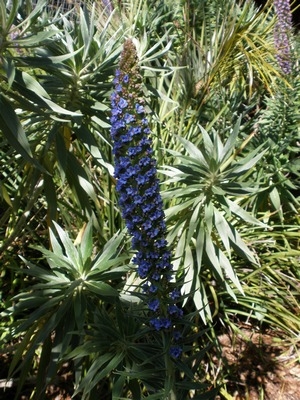 ht tolerant they are perfect for our mountain environment. The color of the spikes varied from pink to lilac, sapphire blue and purple. This gardener is resourceful. He got many of his seedlings along Hwy 17 where they had reseeded after being used as brush to stabilize the slopes after the ’89 earthquake. The bees were really happy visiting the hundreds of blossoms on the beautiful spring day that I was there.
ht tolerant they are perfect for our mountain environment. The color of the spikes varied from pink to lilac, sapphire blue and purple. This gardener is resourceful. He got many of his seedlings along Hwy 17 where they had reseeded after being used as brush to stabilize the slopes after the ’89 earthquake. The bees were really happy visiting the hundreds of blossoms on the beautiful spring day that I was there.
Tucked under wild cherry trees collected in Texas, are second generation iris of dark purple and pure yellow. Originally from his grandmother’s garden in Virginia, these iris are descendants from a light blue variety and a pale yellowish-beige douglas iris.
This extraordinary gardener also has a huge wild rose from Missouri covered now with fragrant white flowers, a wild olive from Texas and a sand plum from Oklahoma. There is a yucca about 4 ft tall that he and his brother started as cuttings when they were teenagers in Port Arthur, Texas. He is also the proud father of a couple of bald cypress complete with "knees". This tree of southern swamps and other low nutrient areas grows woody projections above the ground or water level to act as a structural support and stabilizer allowing them to resist very strong winds. Even hurricanes rarely overturn them.
A beautiful Canary Island palm, planted from a seedling in 1996 that he had nurtured in a gallon can, is now over 9 ft tall. Akebia vines grow up oak trees, passiflora and white wisteria vines up redwoods, a yellow banksia rose rambles up into a madrone and madevillea laxa is happy growing up an oak, too. A willow-leafed hakea salicifolia, indigenous to New South Wales and Queensland, graces his entry with its tiny, white fragrant flowers.
Other trees this gardener loves include Causarina, native also to Australia, sugar pine, incense cedar, Western red cedar, deodar cedar, staghorn sumac and a maytens tree. His mother in Pennsylvania taught him to plant his first garden at age 4 and he cherishes his Eastern white pines, pinus stroblis, and giant sequoias, three of which he grew from seed.
And I can’t forget his collection of salvias. The red flowers spike of salvia confertiflora bloom year round. The beautiful salvia mexicana will soon to be covered with rich, blue flowers. He also grows salvia chiapensis and a salvia-like plant native to Hawaii called salvia lepechinia. This deliciously scented plant will be covered soon with reddish lavender lipstick-like flowers adored by hummingbirds like all the salvias.
A new greenhouse where he has a small collection of orchids will soon house new seedlings that are sprouting in a germination station under lights. Of the many Hawaiian seeds he has collected are maile, a flowering plant that is probably the oldest and most popular material used in leis by early Hawaiians, milo- a chocolate and malt powder popular in many parts of the world, gossypium tomentosum, coral vines, hibiscus and the koa tree.
There were hundreds more cool plants I learned about and got to admire that day. I’ll be visiting this garden again and again for the next round of wonders. it’s a marvel.

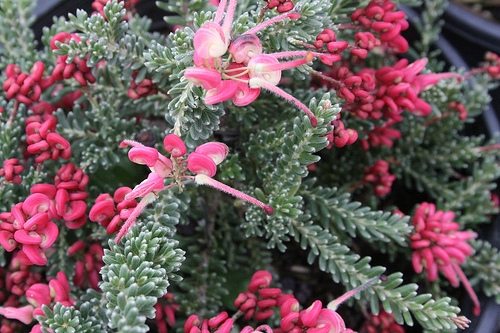
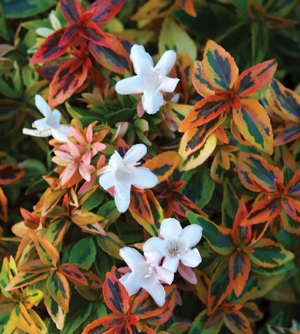 Kaleidescope abelia
Kaleidescope abelia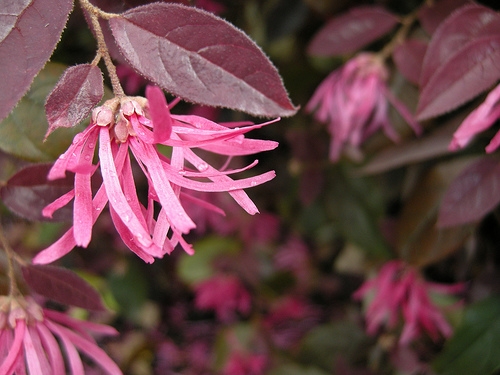 Raspberry flower clusters are heaviest in the spring but some bloom is likely throughout the year. I place this plant in the foreground where you can appreciate it’s graceful shape-looks great as an accent or in a raised bed. The burgundy color can add color to a woodland garden and it even does well in a container on the patio. You can prune it to any size but please don’t turn it into a tight ball and ruin it’s shape. Another plus is that it is not attractive to deer.
Raspberry flower clusters are heaviest in the spring but some bloom is likely throughout the year. I place this plant in the foreground where you can appreciate it’s graceful shape-looks great as an accent or in a raised bed. The burgundy color can add color to a woodland garden and it even does well in a container on the patio. You can prune it to any size but please don’t turn it into a tight ball and ruin it’s shape. Another plus is that it is not attractive to deer. 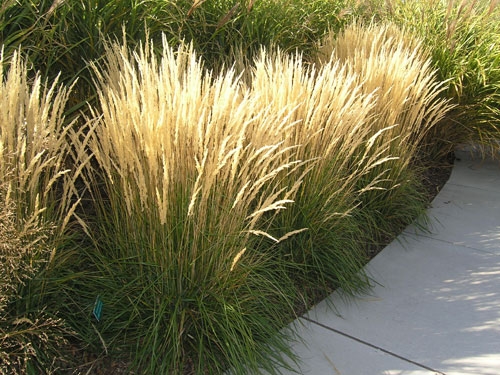 Karl Foerster feather reed grass adds a vertical element to your summer and fall garden. It provides wonderful contrast among low shrubs and perennials. Named after the famous landscape architect and photographer with a love for all aspects of perennial plants, Karl Foerster lived in Germany from 1874 to 1970. This grass won the 2001 Perennial Plant of the Year and although it’s not new on the market it’s an easy to grow ornamental grass that won’t overpower your space.
Karl Foerster feather reed grass adds a vertical element to your summer and fall garden. It provides wonderful contrast among low shrubs and perennials. Named after the famous landscape architect and photographer with a love for all aspects of perennial plants, Karl Foerster lived in Germany from 1874 to 1970. This grass won the 2001 Perennial Plant of the Year and although it’s not new on the market it’s an easy to grow ornamental grass that won’t overpower your space. 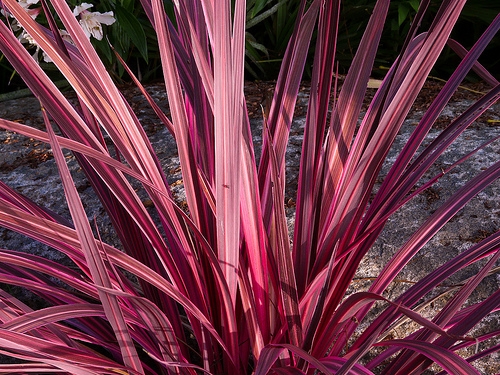
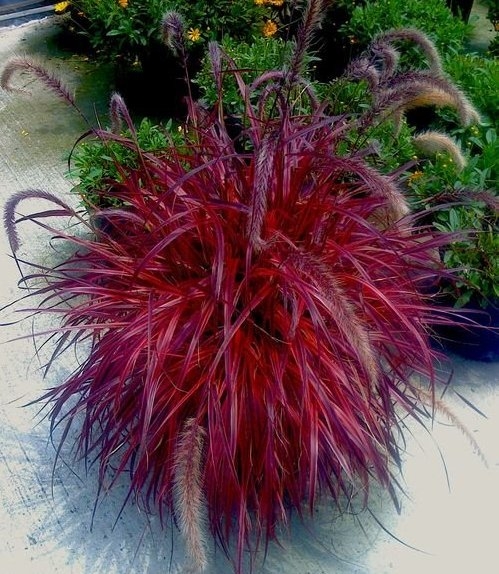 Pennisetum Fireworks
Pennisetum Fireworks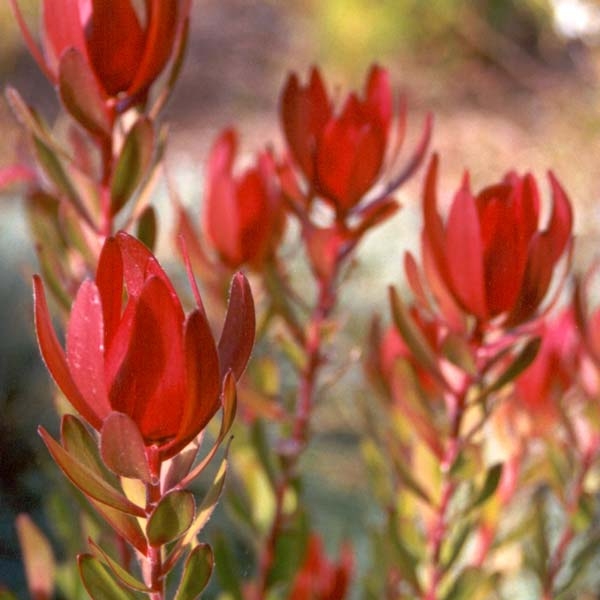 pular Leaucadendron available. It’s a vigorous, erect grower to over 8 feet tall and tough enough to handle frost and clay soils. The flower is actually an insignificant cone surrounded by large colorful bracts which are excellent for cut foliage harvesting.
pular Leaucadendron available. It’s a vigorous, erect grower to over 8 feet tall and tough enough to handle frost and clay soils. The flower is actually an insignificant cone surrounded by large colorful bracts which are excellent for cut foliage harvesting. 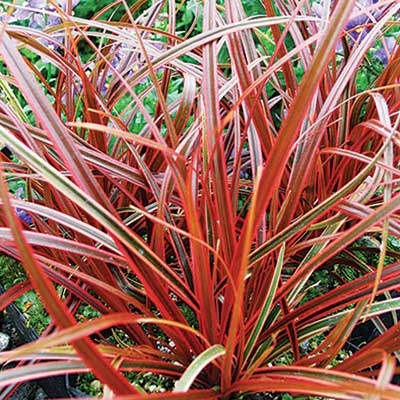
 Euphorbia Diamond Frost blooms continuously with clouds of white flowers that float above finely textured apple-green foliage. This delicate looking perennial may be small in stature, reaching 12-18 " tall and wide, but is easy to grow and surprisingly tolerant of drought and heat. Combine this airy plant with bright colors for a dazzling border.
Euphorbia Diamond Frost blooms continuously with clouds of white flowers that float above finely textured apple-green foliage. This delicate looking perennial may be small in stature, reaching 12-18 " tall and wide, but is easy to grow and surprisingly tolerant of drought and heat. Combine this airy plant with bright colors for a dazzling border.  occasional to regular irrigation. This strong color combination of green and pink doesn’t revert to the parent plants coloring. It’s hardy to 15-20 degrees. You might find this plant also listed as Jubilee.
occasional to regular irrigation. This strong color combination of green and pink doesn’t revert to the parent plants coloring. It’s hardy to 15-20 degrees. You might find this plant also listed as Jubilee. 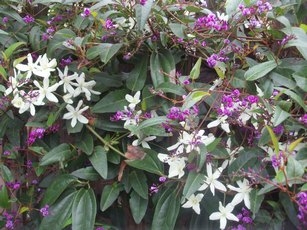 and beautiful blooms, you can have them both when you plant vines. Vines use little space, add color to bare walls and fences, cover free-standing arbors, provide shade and extend the garden skyward. Vines are amazing plants.
and beautiful blooms, you can have them both when you plant vines. Vines use little space, add color to bare walls and fences, cover free-standing arbors, provide shade and extend the garden skyward. Vines are amazing plants.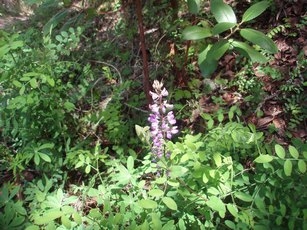 million years ago. According to the Santa Cruz Department of Parks, the silt, sand and mud that had been deposited in that shallow sea later turned into the shale, sandstone and mudstone that make up Quail Hollow today. The diversity of this special place is mirrored in the patchwork of 15 habitats that are located in this small, secluded valley. Mixed evergreen forest, redwoods, grasslands, and a pond with surrounding riparian ecosystem mix with hot, dry chaparral and sandhill environments. The sandy soils here have eroded from the Santa Margarita sandstone and serve as an aquifer for the San Lorenzo Valley.
million years ago. According to the Santa Cruz Department of Parks, the silt, sand and mud that had been deposited in that shallow sea later turned into the shale, sandstone and mudstone that make up Quail Hollow today. The diversity of this special place is mirrored in the patchwork of 15 habitats that are located in this small, secluded valley. Mixed evergreen forest, redwoods, grasslands, and a pond with surrounding riparian ecosystem mix with hot, dry chaparral and sandhill environments. The sandy soils here have eroded from the Santa Margarita sandstone and serve as an aquifer for the San Lorenzo Valley. 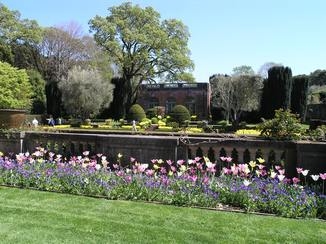 the plants in the garden come to life. I’ve been invited to tour a garden in Scotts Valley in April when many of the early flowering plants will be in bloom. I’ve been to this garden before and there’s always an interesting tree, shrub or flower to enjoy.
the plants in the garden come to life. I’ve been invited to tour a garden in Scotts Valley in April when many of the early flowering plants will be in bloom. I’ve been to this garden before and there’s always an interesting tree, shrub or flower to enjoy. 